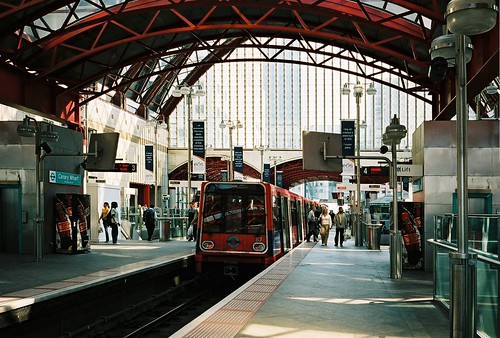The Docklands Light Railway is a curious legacy of the Thatcher period, when London Docklands was designated as an Enterprise Zone. These Zones were a brainchild of planning minister Michael Heseltine and offered planning and tax concessions.
The DLR opened as a Y-shaped route from Tower Hill to Island Gardens, at the north end of Greenwich foot tunnel, and to Stratford, mostly on long-closed railway alignments. Extensions were built first to the Bank, giving it an interchange to the London underground system, and then to Lewisham on the south side of the river, to Beckton to the east and to Woolwich, again on the south side of the Thames. The Lewisham extension was expensive for what it was, involving a long viaduct, diversion of the river Ravensbourne, and burrowing under the railway embankments at Lewisham, to a terminus on the wrong side of a busy roundabout separating it from the main town centre.
Standard overhead electrification was not used, for aesthetic reasons, and an unusual system of bottom-contact third rail electrification was used instead. The trains were fairly conventional lightweight tramway-type vehicles. Driving was automatic ie from the control centre, and the member of staff acted as a general order-keeper and driver in emergency.
The system quickly proved inadequate. The fleet has been replaced three times. Trains have had to be lengthened and stations rebuilt to accommodate them. The system was never going to have the capacity to serve the commercial development at Canary Wharf, and eventually, with a contribution from developers Reichmann, the Jubilee Line Extension was constructed from Bond Street to Stratford, giving through services to Stanmore in north London. One that was open, the development of Canary Wharf could go ahead.
The system gives the impression of being clean and well run and obviously serves a useful function. Whether it is the system that would have been built had it been planned from the start is another question. Due to the larger size of the trains, the tunneling - and there has been quite a mileage built over the years - was considerably more expensive than if some of the line had been built as a tube. Other parts of the route would, more logically, have been developed as conventional railways run with conventional stock, and eventually integrated into London Overground. Other parts again - perhaps the Lewisham route - would probably have been more useful if they had been constructed as conventional on-street tramway, which could then have gone on to Catford and Bromley and perhaps eventually have joined up with Croydon Tramlink. The Jubilee Line Extension would probably have taken a different form if the DLR had opened as a direct tube line from the Bank to Canary Wharf and Stratford. Such a route would also have been more easily extended westwards from Bank, an enhancement which remains on the list of aspirations for the DLR.
Hindsight is a wonderful thing, but already in the early 1980s planning was out of favour in the political right, especially longer-term planning. There was a desire to spend as little as possible at the start. The system, whilst quite good in its own right, is almost certainly not what would have been built if it had been planned from the outset, nor can it have been particularly good value for the money it has cost.


The line opened with just single articulated units, now it runs with three joined together. Both Bank and Canary Wharf were built big enough, from new, to take the much longer units. Most (all?) of the other original stations were built small and have had to be extended, some of them twice.
ReplyDeleteSomeone had the fore-thought to propose that they future proofed these two stations, and some-else had the wit to agree and to find the funds!
Compare and contrast with the today ...
As I said, compare and contrast with today ...
ReplyDeletehttp://www.camdennewjournal.com/news/2013/apr/new-cheapskate-hs2-euston-station-years-disruption-what-benefits